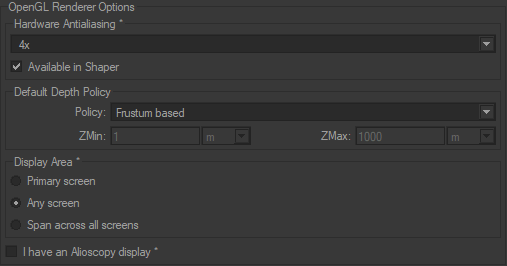Rendering Tab
This tab gathers in two boxes the parameters for the options of the OpenGL engine and the raytracing engine.
OpenGL Engine Options
The Hardware Antialiasing controls the behavior of the antialiasing system of the application used to delete image aliasing effects. Depending on the video card used, it is also possible to disable the hardware antialiasing, or to enable it with different qualities (2x, 4x, 8x, 16x, 32x, 64x).
The antialiasing is enabled in both interfaces, Matter and Shaper, by default. If you do not wish to view the effects of the antialiasing, you can increase rendering speed in Shaper by deactivating antialiasing for Shaper only. To do so, uncheck the box Available in Shaper.
The Default Depth Policy sets the depth buffer. If the default policy Frustrum based does not meet your needs, you can choose between the options Look-At point based and Fixed depth range. This latter option allows you to provide personalized values for the minimum (ZMin) and maximum (ZMax) depths.
The Display Zone sets the default maximum resolution for viewports. Three options are available: Main screen, Maximum dimensions or Cover all screens. Respectively, these options apply the resolution for the main screen, the greatest height and greatest width of the available screens, or allow for the creation of a viewport spanning all screens. When a viewport is displayed in a zone larger than its maximum resolution, black bars are added to compensate for the difference between the maximum resolution and the larger display resolution.

I have an Alioscopy display telling Patchwork 3D that you are using an alioscopy screen that displays 3D in relief without using glasses 3D. This activates the alioscopy options in Matter to adjust the number of renderings that Patchwork 3D must calculate per image to have the 3D in relief on the screen.
Raytracing Engine Options
This zone permits the CPU resources to be allocated to the raytracing engine to be defined. Three options are available: Use all CPU cores, Use all CPU cores but one, and Manual thread count.
The Tile size in pixels can also be set. During the calculation of a rendering via raytracing, the image is rendered and displayed tile by tile in the viewport. The smaller the blocks are, the more fluid the display will be, but the rendering time will also be longer. The height and width of these square tiles corresponds to the number of pixels provided in this field.
